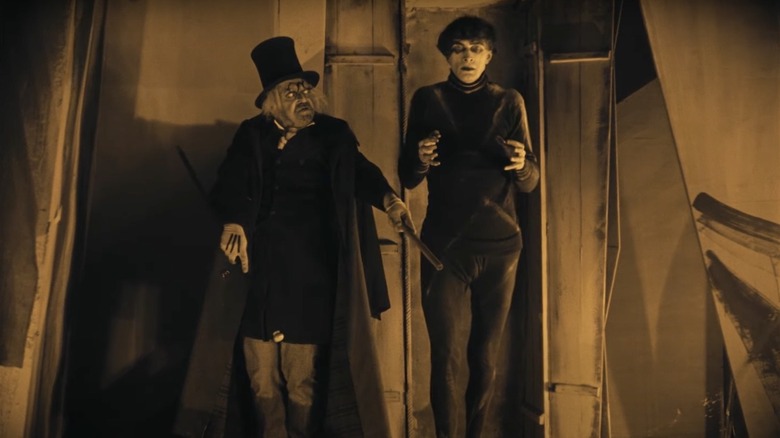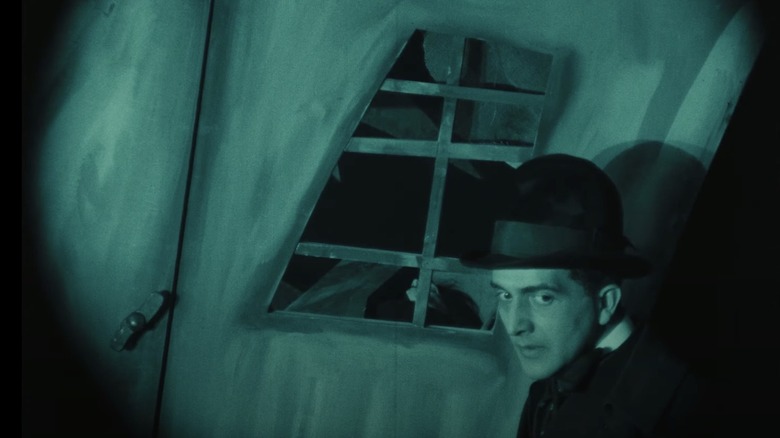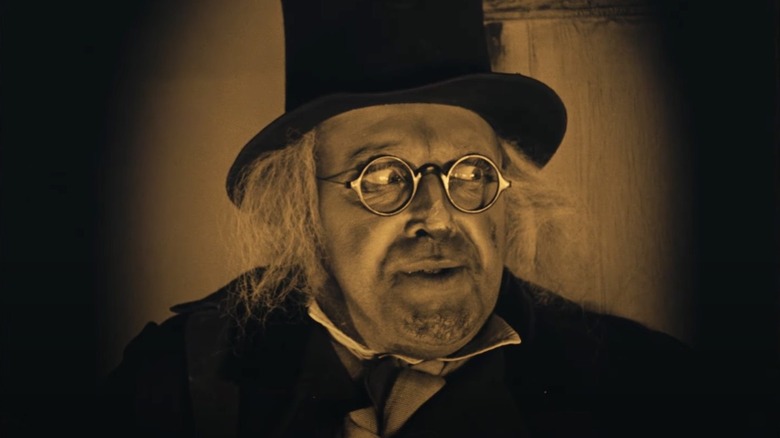The Daily Stream: Come One, Come All, To See The Cabinet Of Dr. Caligari
(Welcome to The Daily Stream, an ongoing series in which the /Film team shares what they've been watching, why it's worth checking out, and where you can stream it.)
The Movie: "The Cabinet of Dr. Caligari"
Where You Can Stream It: Shudder/AMC+
The Pitch: A man recounts the story of how a sleepwalker controlled by a mad doctor carried out murders in his village in this creepy 1920 classic.
German silent films: they've stood the test of time. Written by Hans Janowitz and Carl Mayer and directed by Robert Weine, "The Cabinet of Dr. Caligari" predates "Nosferatu" by two years and is one of the earliest works of German Expressionist cinema. Film critic Roger Ebert, spotlighting it as one of his "Great Movie" picks in 2009, wrote, "A case can be made that 'Caligari' was the first true horror film."
Told mostly in flashback, this 77-minute story unfolds like a demented dream, which "exists at right angles to reality," as Ebert put it. As the movie irises in and out of the tinted past (the restored version uses traditional colors like green and yellow rather than black-and-white), it's not just right angles we see, but slanted doors and windows, a cattywampus carousel, and a hill of houses that's meant to signify the little town of Holstenwall but looks more like flames licking the sky in some hellish bonfire in a kindergartener's crayon drawing.
The camera is straight, but the effect of the production design and set decoration is almost that of Dutch angles, the kind you'd see framing a supervillain's lair in the '60s "Batman" TV series. Are we in a madman's mind, or is Francis (Friedrich Fehér) the sanest one of all, and is it the world around him that's somehow gone mad?
Why it's essential viewing
"The Cabinet of Dr. Caligari" is a film that was highly influential on both film noir and the horror genre. When Dr. Caligari (Werner Krauss) summons the somnambulist Cesare (Conrad Veidt) from his cabinet onstage at the fairgrounds, it's as if we're witnessing Dracula rise from his coffin and Dr. Frankenstein bring his monster to life at the same time — and for almost the first time onscreen. Like the monster, Cesare's story also climaxes with him being chased by a mob.
The difference is, Cesare is a tool. He's been asleep for 23 years, ever since he was born, and only lives to do his master's bidding. This character can be seen as a representation of anyone who metaphorically sleepwalks through life. Creeping into bedrooms, casting his shadow on the wall, you can see in him traces of Count Orlok and the murderer in "M," played by Peter Lorre. Even Rob Zombie would consciously evoke Cesare and "The Cabinet of Dr. Caligari" decades later in his "Living Dead Girl" music video.
The scene where Francis and his friend go to the fair and Cesare prophesizes the friend's demise was inspired by a real fortuneteller predicting the death of Gilda Langer, a German actress in lost films of the silent era. Janowitz and Mayer were pacifists writing in the aftermath of World War I, and some have argued that Dr. Caligari cinematically presaged Hitler and his control over the German masses leading up to World War II.
When we first meet Caligari, he's the little man, with a bureaucrat towering over him on disproportionately tall chair legs. Our perspective changes when Francis follows him into a psychiatric hospital and finds his diary, whereupon we get a flashback within a flashback.
Spoiler alert for a 102-year-old movie...
An inmate running the asylum
The twist ending of "The Cabinet of Dr. Caligari" isn't necessarily as cut-and-dry as it might appear on the surface. It would be easy to think the ending undoes all the previous flashbacks the way "The Usual Suspects" does. When the action moves to the hospital, Francis becomes an iconoclast who calls into question the legitimacy of a literal institution and the man at the head of it. Then, "The Cabinet of Dr. Caligari" superficially discredits him as delusional, putting him in a straitjacket while upholding the institution and the person of authority.
Yet the emotional truth of the movie is such that the audience has learned to be distrustful of Dr. Caligari and sympathetic toward Francis, since it's his point-of-view we've shared. The main narrative, by dint of its sheer length, overpowers the frame story. We get lost in the unreliable narration and it becomes so convincing that, rather than undo the whole film, it makes the ending feel like that much more of a nightmare and injustice.
It's as if the movie would have us doubt our own sanity by showing us the unreal made real. The bad guy wins and is left in charge, and the viewer is left to think, "How can this be true? And not only true, but accepted as the healthy natural order?"
So it goes with the real world, where it really does feel like the inmates are running the asylum sometimes, and where — despite the lessons of two World Wars — countries still haven't stopped sliding into nationalism, just as Germany did. "The Cabinet of Dr. Caligari" is a movie parable that remains ever powerful as it warns of the dangers sleepwalkers can bring about on behalf of institutions run by madmen.


